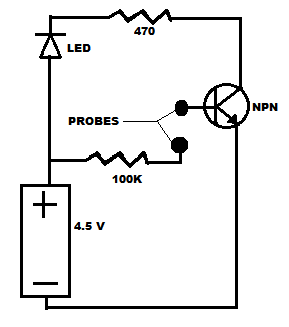Hey everyone! It's been a while since I have posted so im posting here just to make sure you all know i didnt die

Either way, i was experimenting with some schematics i found in an electronic kit and noticed that i could touch two terminals with my hands and the LED would light up. The real circuit had a switch where the probes are on the one below but apparently a human is a good enough conductor to do the job! Well i sketched it all up in paint, so it doesnt look as nice as it could but i didnt feel like modeling it in the PCB design software i have. But if you have an electronic kit or breadboard or some thing to try this circuit out with, try it! Just take two fingers, doesnt matter what hand, and touch each one to one of the two terminals, and the LED should light up if ya got it all wired correctly.
If you do try it, make sure the resistor values are as specified on the picture below or higher as if they are too low, you could burn out the transistor or LED, possibly both. However, if the values are too high, the circuit might not even work, so id just stick with the ones there.


Here's how it works: current from the battery tries to flow from the emitter to the collector of the transistor and through the LED and resistor. But it only can if there is a current flowing from the emitter to the base as well, but that current doesnt need to be big, so your body is able to conduct enough current, even with the 100K resistor which you actually might not need... But there is no way you could get shocked by this as there is too low of a current. Another thing that works quite cool is if you stick the probes in saltwater, it is a great electrolyte and thus conducts awesomely!
Now for a dude who is designing a gaming console, this may not seem like much but this is just a little thing

Before i actually design the main board on the console, i will make a little 4 bit binary adder circuit so i have at least some circuit design experience!
Just a list of components:
470 ohm resistor
100K resistor
NPN transistor
LED
Battery(s) (enough to make 4.5V)